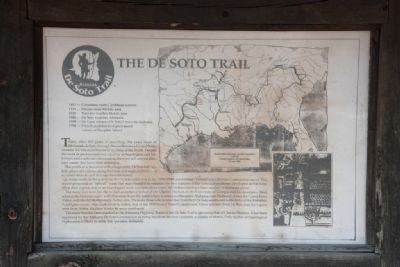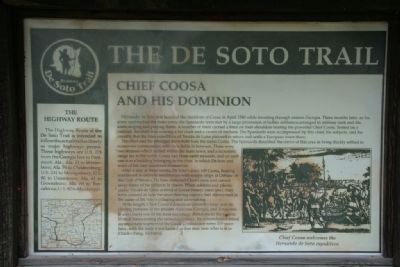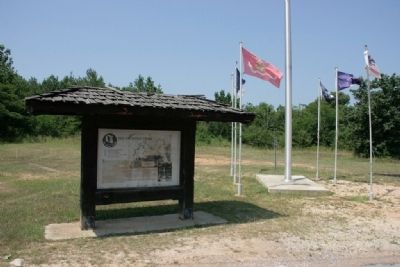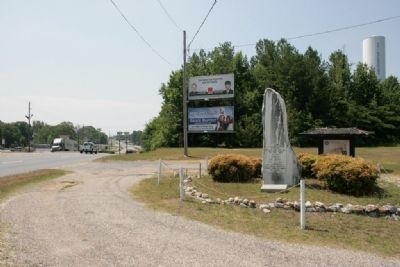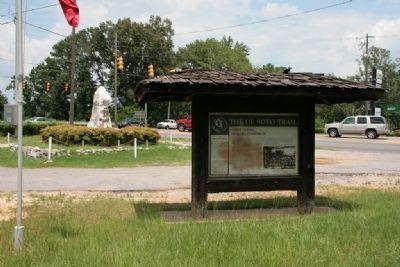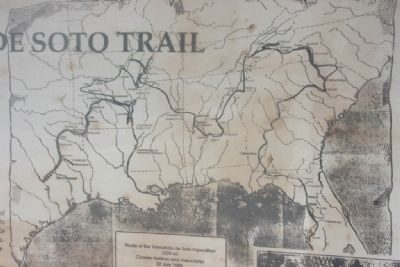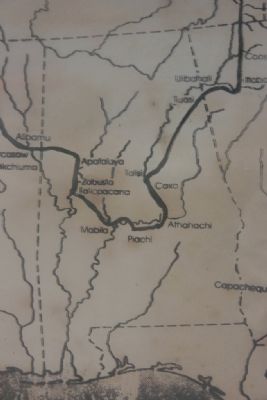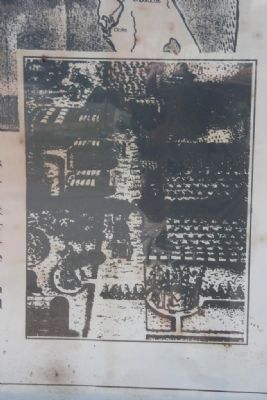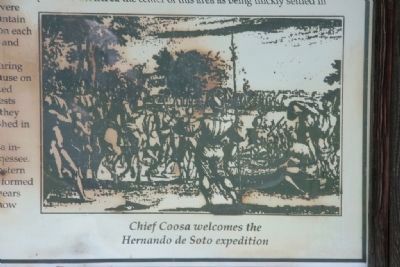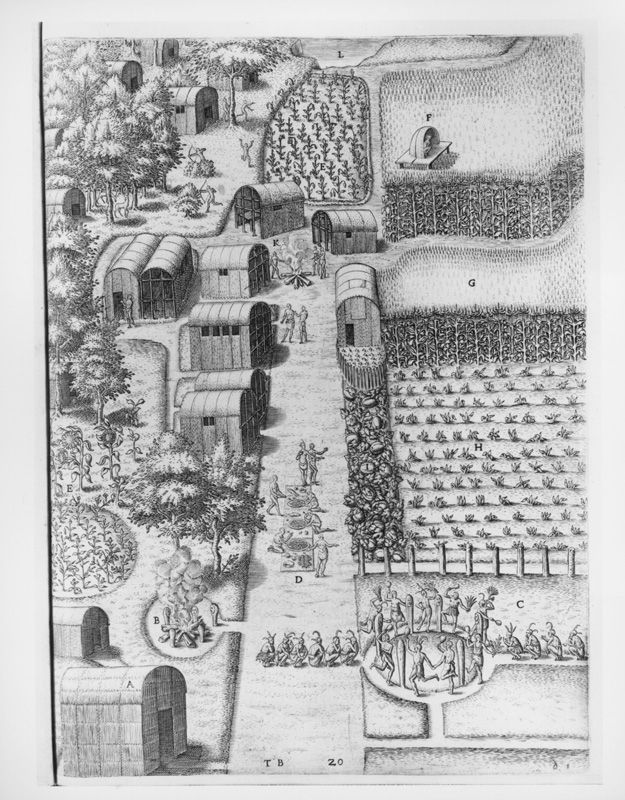Childersburg in Talladega County, Alabama — The American South (East South Central)
The De Soto Trail / Chief Coosa And His Dominion
— Alabama De Soto Trail —
1492 - Columbus visits Caribbean islands
1519 - Pineda visits Mobile area
1528 - Narváez reaches Mobile area
1540 - De Soto explores Alabama
1559 - De Luna retraces De Soto’s route in Alabama
1702 - French establish first permanent colony at Dauphin Island
Today, after 450 years of searching, the exact route of Hernando de Soto through the southeastern United States remains the foremost historical mystery of the South. Despite the work of professional and amateur archaeologists and historians, and a national commission, there are still several alternate routes that have their defenders.
The problem is that even with a large army, De Soto left very little physical evidence along the route and neglected to record accurate latitude and mileage measurements.
A major study in the search for the De Soto route was in the 1939 (400th anniversary) United States De Soto Commission report. This report presented an “official” route that was intended to combine the best features of the various hypotheses developed at that time. Since then a great deal of archaeological work has been done (over 300 Indian sites have been studied in Alabama alone).
The route that now has the widest acceptance is that of Dr. Charles Hudson of the University of Georgia and his associates. Most scholars in Alabama agree with that route from the point where it enters northeastern Alabama near Piedmont, down the Coosa River Valley and into the Montgomery-Selma area. There are those who believe that from there De Soto went south to the forks of the Alabama-Tombigbee rivers. This route tends to follow that of the 1939 United States Commission. Other scholars think De Soto may have gone west from Selma. Hudson thinks he went northwest.
The route that has been marked as the Alabama Highway Route of the De Soto Trail is primarily that of Charles Hudson. It has been approved by the Alabama De Soto Commission as being based on the best currently available evidence. Only further archaeological exploration is likely to settle this question definitely.
Reverse:
Chief Coosa And His Dominion
Hernando de Soto first heard of the chiefdom of Coosa in April 1540 while traveling through eastern Georgia. Three months later, as his army approached the main town, the Spaniards were met by a large procession of Indian noblemen arranged in military rank and file, some singing and playing flutes. A number of them carried a litter on their shoulders bearing the powerful Chief Coosa. Seated on a cushion, the chief was wearing a fur cloak and a crown of feathers. The Spaniards were so impressed by this chief, his subjects, and his country that the
later expedition of Tristan de Luna planned to return and settle a European town there.
The chief and his principal town both bore the name Coosa. The Spaniards described the center of this area as being thickly settled in numerous communities with corn fields in between. There were two streams which united within the main town, and a mountain range lay to the north. Coosa had three earth mounds, and on each one was a building belonging to the chief, in which De Soto and some of his men quartered themselves.
After a stay of three weeks, De Soto's army left Coosa, bearing southward in order to rendezvous with supply ships at Ochuse on the Gulf of Mexico. De Soto abducted Chief Coosa and carried away many of his subjects in chains. When soldiers and priests under Tristan de Luna arrived at Coosa twenty years later, they were amazed at how the once-thriving country had diminished in the wake of De Soto's pillaging and slave-taking.
At its height, Chief Coosa's dominion covered a large area including portions of the present Alabama, Georgia, and Tennessee. It was clearly one of the most important chiefdoms in the eastern United States during the sixteenth century. Its descendants formed an important segment of the Creek Confederacy some 200 years later, with the main town located at that time near what is now Childersburg, Alabama.
Topics. This historical marker is listed in this topic list: Exploration. A significant historical month for this entry is April 1540.
Location. 33° 16.624′ N, 86° 21.564′ W. Marker is in Childersburg, Alabama, in Talladega County. Marker is at the intersection of U.S. 280 and Childersburg Fayettville Highway (State Highway 76), on the right on U.S. 280. Touch for map. Marker is in this post office area: Childersburg AL 35044, United States of America. Touch for directions.
Other nearby markers. At least 8 other markers are within 8 miles of this marker, measured as the crow flies. De Soto's Visit (here, next to this marker); History Of Childersburg (approx. 0.3 miles away); Coosa (approx. 2.2 miles away); DeSoto Caverns (approx. 5.1 miles away); Harpersville Garden of Memories (approx. 6.1 miles away); Historic Harpersville (approx. 6.3 miles away); Confederate Forts (approx. 6.7 miles away); Stars Fell On Alabama / Hodges Meteorite (approx. 7.1 miles away). Touch for a list and map of all markers in Childersburg.
Also see . . .
1. Hernando de Soto. Wikipedia biography (Submitted on July 10, 2011, by Timothy Carr of Birmingham, Alabama.)
2. Coosa Chiefdom. Wikipedia entry (Submitted on June 26, 2021, by Larry Gertner of New York, New York.)
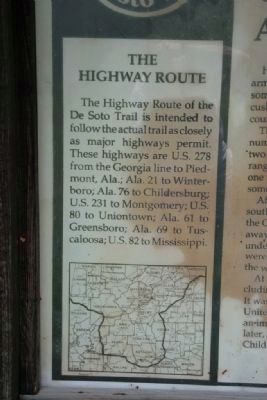
Photographed By TRCP Alliance, July 23, 2011
9. The Highway Route
The Highway Route of the De Soto Trail is intended to follow the actual trail as closely as major highways permit. These highways are U.S. 278 from the Georgia line to Piedmont , Ala.; Ala. 21 to Winterboro; Ala. 76 to Childersburg; U.S. 231 to Montgomery; U.S. 80 to Uniontown; Ala. 61 to Greensboro; Ala. 69 to Tuscaloosa; U.S. 82 to Mississippi.
Credits. This page was last revised on December 23, 2023. It was originally submitted on July 5, 2011, by Timothy Carr of Birmingham, Alabama. This page has been viewed 1,901 times since then and 104 times this year. Last updated on August 3, 2011, by Timothy Carr of Birmingham, Alabama. Photos: 1. submitted on July 5, 2011, by Timothy Carr of Birmingham, Alabama. 2. submitted on August 3, 2011, by Timothy Carr of Birmingham, Alabama. 3, 4. submitted on July 10, 2011, by Timothy Carr of Birmingham, Alabama. 5. submitted on August 3, 2011, by Timothy Carr of Birmingham, Alabama. 6, 7, 8. submitted on July 10, 2011, by Timothy Carr of Birmingham, Alabama. 9, 10. submitted on August 3, 2011, by Timothy Carr of Birmingham, Alabama. 11. submitted on February 24, 2018, by J. Makali Bruton of Accra, Ghana. • Bill Pfingsten was the editor who published this page.
